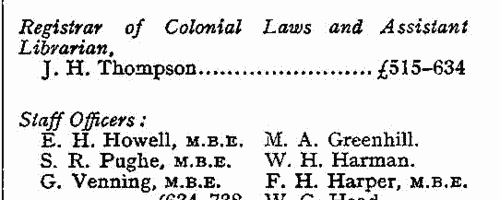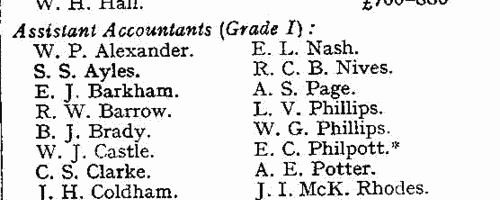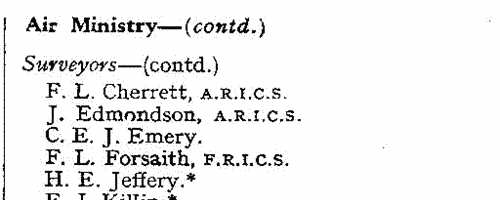Birse Surname Ancestry ResultsOur indexes 1000-1999 include entries for the spelling 'birse'. In the period you have requested, we have the following 20 records (displaying 11 to 20): Single Surname Subscription | | | Buying all 20 results of this search individually would cost £110.00. But you can have free access to all 20 records for a year, to view, to save and print, for £100. Save £10.00. More... |
These sample scans are from the original record. You will get scans of the full pages or articles where the surname you searched for has been found. Your web browser may prevent the sample windows from opening; in this case please change your browser settings to allow pop-up windows from this site.  London Metropolitan Police
(1902-1911) London Metropolitan Police
(1902-1911)
The London Metropolitan Police Register of Joiners (MEPO 4/337) lists policemen joining the force 14 July 1902 to 10 April 1911 (warrant numbers 88812 to 100006). The register is alphabetical, in so far as the recruits are listed chronologically grouped under first letters of surname. It gives Date of Appointment, Name, Number of Warrant, Cause of Removal from Force (resigned, dismissed, promoted or died), and Date of Removal. The information about removal is sometimes wanting. A final column of 'Remarks' is largely blank, but occasionally gives an alias or a cross-reference to another warrant number. The register is discoloured and damaged in places, and one or two pages are missing.BIRSE. Cost: £8.00.  | Sample scan, click to enlarge

| Officers of the British Army and of the Indian Army
(1934)
The Half-Yearly Army List, issued By Authority, 30 June 1934, lists all officers in active service at that date, and this list was evidence of the status and rank of the officers contained in it. The entries are set out as a gradation list, by rank, from field-marshals to lieutenants, and within each rank in order of seniority at that rank. Each officer's name (surname first, in capitals, then christian name and present rank (with date of achieving that rank) and regiment &c. are given, for convenience, in bold type, with any national decorations in italics after the name. Each entry also gives date of birth, number of days service in the ranks, dates of service in each rank of officer, particular offices and postings (with dates) and, where appropriate, a summary of war service, and medals. For all but the oldest of the officers then serving, the war service details are for the Great War (1914-1921), and campaigns in Iraq, Waziristan, and the North West Frontier of India. War services are not given in this edition for Indian Army officers, except in that their entries are preceded by a crossed swords symbol where they have seen war service in a theatre of war overseas. After the gradation list of officers, there is a section for the Royal Malta Artillery; and then (pages 1152 to 1185) warrant officers - staff or garrison serjeant-majors, educational serjeant-majors, serjeant-major (physical training and educational) instructors, regimental serjeant-majors (and corporal-majors, farrier-serjeant majors, master gunners, assistant instructors in gunnery, experimental serjeant-majors, artillery clerks, farrier-serjeant-majors, artificer serjeant-majors, clerks of works, mechanist, superintending clerks, draughtsmen, 1st class staff serjeant-majors, transport, supply, conductors, sub-conductors, armourers, armament artificers, headmasters, schoolmasters, marine gunners, and bandmasters. The section for the Royal Army Chaplains' Department lists all chaplains (1st to 3rd class); and that for Queen Alexandra's Imperial Military Nursing Service has all matrons, sisters and staff nurses. The lists of nurses do not give date of birth: all are unmarried. The book concludes with the Yeomen of the Guard, the Honourable Company of Gentlemen-at-Arms, and the King's Body Guard for Scotland, in each case giving name (surname and initials, not christian names), honours, name of late regiment, and date of appointment.
BIRSE. Cost: £4.00.  | Sample scan, click to enlarge

| British Civil Servants
(1935)
The British Imperial Calendar lists civil servants in Britain, arranged according to the organizational structure of the state, and shows their qualifications and salaries. BIRSE. Cost: £4.00.  | Sample scan, click to enlarge

| British Civil Servants
(1940)
The British Imperial Calendar lists civil servants in Britain, arranged according to the organizational structure of the state, and shows their qualifications and salaries. BIRSE. Cost: £4.00.  | Sample scan, click to enlarge

| British Dentists
(1950)
The Dentists Register is the official register of British dental practitioners. For each dentist the original certificate number is given; name (surname first, in bold; in the case of married women, maiden name is also usually given); address (in italics); date of registration; and the qualification entitling registration, with any additional qualifications, with year and place of qualification. Many of the older dentists, already practising by 1921, were qualified by virtue of the Dentists Act of that year.BIRSE. Cost: £4.00.  | Sample scan, click to enlarge

| Chemists
(1950)
The Royal Institute of Chemistry was founded in 1877, and was open only to British subjects (and also, in due course, to citizens of the newly-created Republic of Ireland). Associates of the institute (A. R. I. C.) qualified either by studying chemistry, physics, mathematics and an optional science for the institute's examination (which insisted on a high standard of practical laboratory efficiency); or by obtaining good honours degrees or equivalent qualifications, with chemistry as principal subject, and having undergone training in allied sciences. Associates of at least three years' standing could then be admitted to the Fellowship (F. R. I. C.) either by taking a further examination in a special branch of chemistry, or by submitting the results of work or evidence of experience sufficient to justify the Council in granting exemption from such further examination. This register of fellows and associates, correct to 31 August 1950, contains 11,545 names, arranged alphabetically, surname first (in capitals), with qualifications, current address, telephone number, and (in italics) a brief description of present post in the chemical industry. Finally, year of admission as associate (A.) (and, where appropriate, fellow (F.) is given on the right-hand side. With this may appear the notation (x) for a fellow of the Chemical Society, (y) for a member of the Society of Chemical Industry, or (z) for a joint subscriber to all three chartered bodies.BIRSE. Cost: £4.00.  | Sample scan, click to enlarge

| Estates of the Deceased: Notices under the Trustee Act
(1950)
Under the Trustee Act 1925 s. 27, notices were gazetted giving the names of deceased (surname first, in capitals); address, description, and date of death; names, addresses and occupations of persons to whom notices of claims against the estate were to be given, and names (in brackets) of personal representatives; and the date on or before which notices of claim were to be given. May 1950.BIRSE. Cost: £4.00.  | Sample scan, click to enlarge

| British Civil Servants
(1953)
The British Imperial Calendar lists civil servants in Britain, arranged according to the organizational structure of the state, and shows their qualifications and salaries. BIRSE. Cost: £4.00.  | Sample scan, click to enlarge

| Flight Lieutenants: Equipment Branch
(1957)
The Air Force List for 1957 contains gradation lists for all serving officers, corrected, generally, up to the appointments and promotions gazetted 2 April 1957. The officers are listed by branch, rank, and date of seniority; the names are given surname first, initials, decorations, and various sets of initials relating to their particular qualifications or expertise. A double-headed dagger before the name denotes a permanent direct commission; a dagger a national service commission; an asterisk some other non-permanent commission. The main abbreviations are: a. a., qualified at Army Long Gunnery Staff Course (A. A.); c. f. s., qualified flying instructor (with an asterisk if A1 category, without, A2); I, 1st class interpreter; i, 2nd class interpreter; i. d. c., completed a course at the Imperial Defence College; j. s. s. c., completed a course at the Joint Service Staff College; P, on probation; p. f. c., graduate of Pilot Flying College; p. s. a., graduate of R. A. F. Staff College; p. s. c., graduate of Military Staff College; q. s., R. A. F. graduate of the Military or Naval Staff College; Sp, medical or dental specialist; t. p., graduate of Empire Test Pilots' School; Z, qualified in A. I. S. Inspection Duties. BIRSE. Cost: £4.00.  | Sample scan, click to enlarge

| Naval Officers
(1957)
The Navy List for 1957, corrected to 18 January 1957, includes this main catalogue of 'Officers on the Active List of the Royal Navy and the Royal Marines and Retired and Emergency Officers Serving'. The first column gives surname and initials. The second column is rank, with a profusion of abbreviations, most of which are self-evident, often qualified by a specialisation, in brackets. The third column is for specialisations not demonstrated in rank. Fourth column is date of seniority (those given in italics are of ranks held previous to 1 January 1957 by Special Duties Officers); and fifth column, where serving. BIRSE. Cost: £4.00.  | Sample scan, click to enlarge

|
 | 1 | 2 |
Research your ancestry, family history, genealogy and one-name study by direct access to original records and archives indexed by surname.
|













